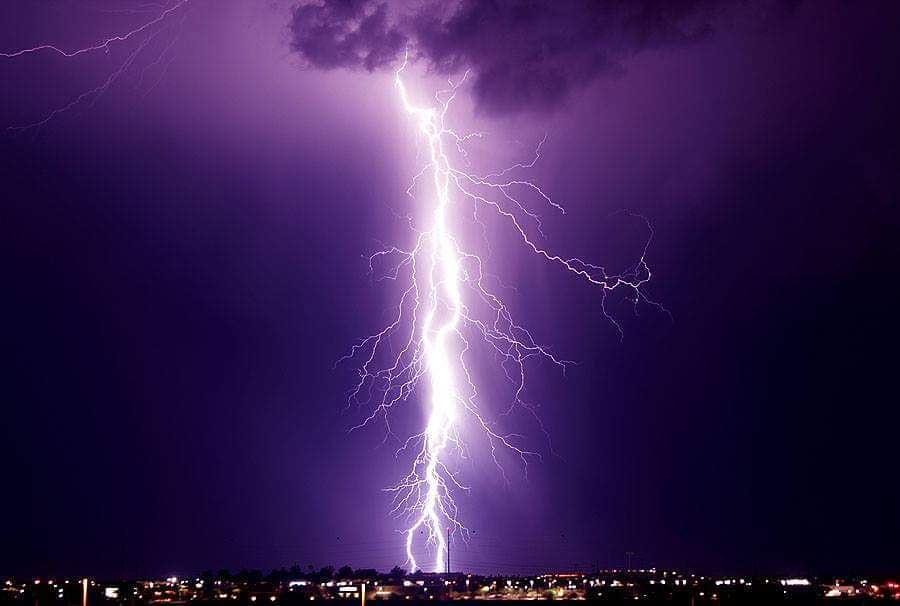What is an Arizona monsoon?
The term “monsoon” comes from the Arabic “mausim” meaning “season.” Simply put, the monsoon is the time of the year, or the season, when winds shift, bringing an increase in moisture to the Southwest. The resulting storms can range from minor blowing dust to severe thunderstorms.
Often, the more severe storms begin with towering walls of dust hundreds of feet high that move across the Valley. These dust walls are known as “haboobs,” an Arabic term for the similar walls of dust that are common in the Middle East. With the dust comes high winds, usually followed by heavy rains.
At times, the thunderstorms can result in microbursts, which are the result of cold, dense air from a thunderstorm hitting the ground, bringing with it intense winds. These winds spread out in all directions and have the potential to cause intense damage.
Interesting fact: The wettest monsoon in Phoenix was in 1984, when 9.56 inches of rain fell at Phoenix Sky Harbor International Airport; the driest was 1924 when only 0.35 of an inch was recorded.
What is a haboob?
A haboob is a type of intense dust storm with a characteristic, giant wall of dust that is created as strong winds flow downward and outward as they exit a collapsing thunderstorm. These desert sand and dust storms generally last a couple of hours, blow from any direction and are more common in the summer months.
When is Arizona's monsoon season?
Before 2008, the monsoon’s start date and duration varied based on the dew point average. (The official Arizona monsoon starts after the third consecutive day of dew points above 55 degrees and ended when it dropped again.) To reduce confusion, the National Weather Service decided to set dates. Now, the season officially begins on June 15 and ends on September 30 which happens to coincide with great Arizona Staycation rates and Chandler hotel deals for summer.
Just for reference: Based on the dew point method, the monsoon would usually start, on average, around July 7 and conclude approximately two months later, soon after Labor Day.

What do I need to know about visibility?
Monsoon storms can produce several hazards, including dust, wind damage, and flooding. If you are driving and see a wall of wind approaching, get to a safe place as soon as possible. This can mean going directly home or to your hotel, if you have the time, or it can mean exiting the freeway, pulling into a parking lot, and waiting out the storm.
If you don’t have time to do either before your visibility is suddenly reduced by dust or heavy rains, slow down and keep driving straight. Don’t make unnecessary lane changes. If you feel like conditions are too bad to continue driving, slowly pull off the side of the road as far right as you can, turn off your car, turn off your lights, and keep your foot off the brake pedal. Otherwise, drivers might come up behind you and, thinking you are still in motion, and rear-end your vehicle.
Do monsoons cause flooding?
Because the rest of the year is so dry, the ground in the Valley has a difficult time absorbing the intense monsoon rains. Washes fill quickly, and entire streets may even flood. A few years ago, I-10 was impassable for a brief period.
Whatever you do, don’t underestimate the flowing water! What looks like only an inch or two can be much deeper. As little as 6 inches can sweep you off your feet and 24 inches can wash your car off the road. Even a high-clearance vehicle is at risk in just 24 inches.
If you approach an area with running water, DO NOT attempt to cross it, especially if a nearby sign warns against crossing when flooded. Arizona has what’s called the “Stupid Motorist Law,” which allows municipalities and rescue agencies to charge you for the cost of being rescued if you fail to observe posted warnings. Your miscalculation can cost you not only financially but it can cost you your life.
So, what should you do if there are no signs posted and you stall in a wash or other flooded area? Try to climb out on the roof of your car and use your cell phone to call 911, if you can. Rescue workers will come to your aid as soon as possible.
What should you do during a monsoon?
• Remember to drive cautiously even if your visibility is not greatly reduced, especially at the beginning of a storm when oils and other automotive fluids can make the road unusually slick.
• If you are caught outside, stay away from open fields, high land, trees, poles, and other tall objects to avoid being struck by lightning. You also want to avoid swimming pools and golf clubs.
• Stay off the phone, if you have a landline (or are in a hotel that does) to avoid getting a shock from a nearby lightning strike. Use your cell phone, if you must, but even this should be minimized to keep lines open for emergencies.
• Avoid plumbing fixtures, including showers, baths, and sinks, since lightning can travel through metal pipes. A monsoon storm is not a good time to take a shower.
• Keep your distance from windows, which can be struck by blowing debris, including trees. It’s not uncommon for high winds to knock over large trees, and if you’re next to a window at the time, you can suffer severe injury from flying glass.
